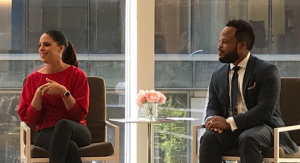Before becoming head of NLADA, Jo-Ann was the organization’s senior vice president for programs, responsible for oversight of both the civil legal aid and public defense program agendas. From 1994 to 2000, she served as director of the Public Defender Service for the District of Columbia, widely regarded as the nation’s model defender agency.
Jo-Ann is a founder of the American Council of Chief Defenders, a leadership council of the top defender executives from across the United States, and the District of Columbia Appellate Practice Institute. Her extensive experience lecturing includes serving as a member of the visiting faculty for the Trial Advocacy Workshop at Harvard Law School. Jo-Ann received recognition from the White House as a “Champion of Change.”
Tell us about your leadership style and how this contributes to your organization’s success.
Because the quality of justice should not depend on how much money a person has, the mission of the National Legal Aid & Defender Association (NLADA) is to promote excellence in the delivery of legal services for people who cannot afford counsel.
My personal experiences stoked the flames of my passion for justice and deeply held belief in respecting the dignity of every person, regardless of their circumstances. As a young child, I learned about my father’s experiences among those who participated in desegregating the U.S. Navy during World War II. My family was raised in rural Connecticut because that is the only place in the state that would hire a young black male (my father) as a public school teacher at that time. Growing up in the first African American family in the town, I was no stranger to biting words or unfair treatment.
At bottom, justice is about treating people fairly and respectfully. As I often say to NLADA staff, it is about “treating people right”. As a standard bearer for equal justice, it is incumbent upon us to model the way, which begins with how we treat each other and extends to our members and the clients and communities that they represent. These principles ground my leadership, and are effectuated on a daily basis through listening, guiding, mentoring and encouraging creative and transformational activities that can substantially expand access to justice.
NLADA embraces leadership development as a key, cost-effective strategy for achieving our mission. We like to say that “leadership is everybody’s business”, and that it entails values, knowledge and skills that can be taught and learned. The civil legal aid initiative has increased federal grant funding for legal services by more than $30 million dollars by helping legal aid leaders expand their funding through training, information and other resources. As a strategic ally of the MacArthur Foundation’s “big bet” to reduce unnecessary incarceration by changing how America uses jails, NLADA works to support chief defenders’ ability to be transformational leaders who are playing key roles in making criminal justice systems more fair and effective.
While we rely upon the expertise of established leadership professionals and the plethora of materials that exist on “leadership”, as we work to support the development of leadership skills among staff and our member community one resource in particular, the Leadership Practices Inventory (“LPI”), continues to resonate with our organization’s core values and is a staple among the resources that we utilize to train social justice leaders.
The LPI helped to shape my early understanding of leadership as a discipline and formed the foundation of an analytical framework that continues to guide me daily. Focusing on the “Five Exemplary Leadership Practices”, inspiring a shared vision, encouraging the heart, enabling others to act and modeling the way, while continually challenging injustice and the status quo, has also served NLADA well. It has helped us to be a high performing, impactful organization as we work to ensure that low income and other vulnerable individuals have access to legal assistance to help them with basic human needs. Creating the first national Vista program for public defense programs; garnering the support of more than 250 corporate leaders to defend the Legal Services Corporation against the threat of elimination; and partnering with established organizations like the American Bar Association or a novel technology startup to increase access to justice are just a few of the many ways in which NLADA’s small but mighty staff team and dedicated national community of leaders are able to get us closer to making real the promise of justice upon which this country was founded. Believing in people, encouraging and supporting our staff, members and partners and providing opportunities for them to be their best selves – to be impactful, transformative leaders – have been essential components of our successful endeavors in expanding access to justice.
What advice would you offer for other nonprofit leaders?
Teaching and enabling others are critical components of leadership, and to be life-long teachers, we must commit to being life-long learners who embrace change. There are three aspects of this that are particularly important in our current environment.
First, in this technologically driven information age, it is more important than ever to look beyond our own communities and areas of expertise to embrace a broader, multi-disciplinary approach to our work. Technology has exponentially expanded our ability to access information and acquire knowledge. With it has come increased expectations regarding areas of mastery in defining nonprofit success, and often increased complexity in the substantive arenas upon which our missions focus. “Evidence-based” and “research-informed” practices are becoming the rule, and often the evidence or research on a particular issue of relevance will be generated in governmental or for-profit, i.e., outside of the nonprofit context. Learning and leading from a perspective that values these practices and that includes seeking knowledge and expertise that may fall outside of the nonprofit sector is becoming more critical.
Second, focusing individually and organizationally on cultural competence and skills that foster equity and inclusiveness, have always been the right things to do. In the increasingly globally-connected world, they are now becoming a business imperative, as well as a moral one.
Finally, ensuring that our efforts are carried out in organizations that effectively support a multi-generational workforce and that proactively work to develop the next generation of social justice leaders will go a long way to addressing items one and two, above. Moreover, the nonprofit sector has a key role to play in creating the peaceful, prosperous world to which we all aspire. Our outcomes will depend upon our ability to coach and train a new generation of leaders, providing them with access to knowledge gained from seasoned leaders and past history, while encouraging them to forge new and different paths to a better future.
What does this award mean for you and your organization?
The EXCEL award would support NLADA’s commitment to leadership development in the equal justice community. It would permit NLADA to more readily access the Center for Nonprofit Advancement’s (“the Center”) wealth of information and tools as a member organization, which in turn would provide new resources to pass on as we train and convene more than 3000 equal justice leaders annually. It would help NLADA encourage leaders to explore and locate leadership coaches as one way of strengthening their effectiveness. Importantly, the NLADA Board of Directors passed a resolution calling on legal aid and public defense leaders to encourage staff to take the Harvard Implicit Bias test, and to provide training that promotes diversity, equity and inclusion. The resources accompanying the award would support our continuing efforts to identify professional trainers and provide additional experience with them as we “model the way” in this challenging, but important area.
The EXCEL Award would also introduce NLADA to the Center’s extensive membership and help us expand cross-disciplinary partnerships. Society does not always look favorably upon lawyers. When people understand what the NLADA community of lawyers does, and their role in providing representation to the most vulnerable among us, they have a very different, positive reaction.
At NLADA, part of our collective vision is for everyone to understand how civil legal aid and public defense make society better. We are working to build bridges across sectors including educating nonprofit leaders to understand that advocates in the legal community who are on the frontline of justice every day share many of their social objectives, and that partnering with NLADA can maximize and leverage scarce resources. For example, it can be helpful for nonprofits that focus on homelessness to know that civil legal aid advocates often have the ability to leverage the law to keep people in their homes. If healthy communities or access to medical treatment is a nonprofit’s focus then it is worth knowing that Medical Legal Partnerships (MLPs), which are collaborations between attorneys and physicians and other healthcare professionals, are demonstrating that sometimes, the right prescription for a medical condition is a legal one. In other words, it often takes legal skills to get a landlord or employer, for example, to address issues that may have created or exacerbated a health problem. For those focused on issues of racial, gender or ethnic equality, it can be useful to know how public defense leaders and practitioners are addressing inequity in juvenile and criminal justice systems or how they are working to dismantle what is often called the “school to prison pipeline”.
Thus, in addition to supporting our work through organizational and professional development, the ability to reach the Center’s broad nonprofit constituency would provide new, invaluable opportunities to introduce NLADA’s national community of advocates to nonprofit leaders in many different disciplines. Indeed, the selection process itself already is opening up dialogues that have the potential to lead to more expansive collaborations as we work to expand justice, opportunity and equality. If that happens, we have all already won!
Share This Page:
 With budget constraints tighter than ever, you may be thinking how can your nonprofit possibly afford to offer paid (or even unpaid) sabbaticals? But in today’s climate, the real question is how can you afford not to?
With budget constraints tighter than ever, you may be thinking how can your nonprofit possibly afford to offer paid (or even unpaid) sabbaticals? But in today’s climate, the real question is how can you afford not to? Those who attended this year’s sold out event were especially impressed with our featured guest, Soledad O’Brien.
Those who attended this year’s sold out event were especially impressed with our featured guest, Soledad O’Brien.